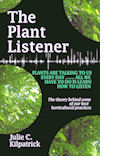Growing Plants Under Lights
The best light that any plant could wish for is sunlight. However, there are occasions when growing under artificial light is the only option.
It may be you have houseplants located in a dark corner, or you may want to start your seedlings off indoors, or maybe you want to grow micro-greens or herbs in the kitchen where they'll be nice and handy for picking. Those of us with very small gardens or indeed no garden at all can still grow some things successfully indoors. In most cases, that means supplementing your lighting articially.
Grow lights will let you set up just about anywhere you have the space. For starting off seedlings, growing herbs or micro-greens, there are some great little kits out there that incorporate a seed tray or containers with the lighting system above.
This little kit (pictured below),from Gardening Naturally, is just one example of the systems available. It has four pots so you can grow a choice of herbs and salads and an adjustable light canopy.

If you have houseplants in a dark corner, all you really have to do is hang your light above them or use a lamp with a flexible head and train the light onto your plants.
If you're bringing on a lot of seedlings, then your set-up probably won't be all that pretty. You can utilise a spare cupboard for this but make sure there is sufficient air circulation. Improve light reflection by painting the inside of the cupboard white.
Wherever you decide to set up your indoor growing system, there is one important point to remember - cleanliness is the key. In the warm indoors environment, pests and diseases will quickly spread so you want your equipment and growing area to be as sterile as possible. Make sure you sterilise all your seed trays and pots and only use new, clean compost.
This is where it all gets really complicated - if you want to make it that way. A simple search on the Internet will present you with a vast array of lights for you to choose from - incandescent plant lights, daylight fluorescents, metal halides, high pressure sodium. Some of these lights can be very expensive and, certainly if you decide to grow plants indoors as a serious hobby, you could invest in something more sophisticated. Alternatively, you could make do with simple full-spectrum grow lights which you can now buy online at a very reasonable price.
Whatever lights you choose, it is helpful if you can adjust the height of them as the plants grow.
Ideally, you should place your lights directly over the plants, around four to eight inches away from the top. With fluorescent bulbs or LEDs, you won't get much heat but make sure you won't damage the plant by placing your hand under the bulb. If you feel it hot, then the plants will too and you should move the light source away a bit.
Plants need light, that's true, but they also need darkness. How many hours of darkness will depend on the plant but, as a general rule, you should think about the number of hours sunlight there would be if you were growing this plant outdoors. In other words, consider when you would normally sow your seeds outdoors. What would be the number of hours daylight during that time? As the plants mature, you would increase the amount of light accordingly. It's best to have your lights set to a timer switch for this.
For houseplants, think about where they come from. Tropical plants will need 12 hours of diffused light whereas desert plants need more intense light for longer.
Don't be tempted to over water or over feed. Keep a close eye on your plants and they'll tell you when something's wrong. If they start to look sickly, you should consider your watering and feeding regime first. If they are growing 'leggy' - that is, a tall stem with a stunted leaf growth at the top, then you don't have sufficient light and should install more, or move the light source closer to the plants.
If you intend to move your plants outdoors, you will have to prepare them for the shock of leaving the nest. Put them outside during the day and bring them back in at night for a few weeks or until there is no more danger of frost but remember, the plants may be used to more hours of sunlight in your artificial growing system, so they might need to be put back under lights for an hour or two when you bring them indoors. Plants respond very much to the length of the day (or rather the hours of darkness) and you'll only confuse them if you suddenly give them eight hours of light when you've been giving them twelve. They will interpret this as a seasonal change and may respond accordingly.
Once you've got them fully hardened off, you can put them outside.
Consider also putting your houseplants outdoors for a few hours each day in summer, just to give them a taste of real sunlight. Remember though, introduce them gradually to the outdoors and keep them in a well sheltered place away from wind. Bring them back indoors well before there is a likeliehood of frost. Tropical houseplants with large leaves won't normally like it in full sun so, put them in shade or dappled light when they are on their holidays outside.
Julie is a lecturer in horticulture, editor of Gardenzine and author of the book The Plant Listener









